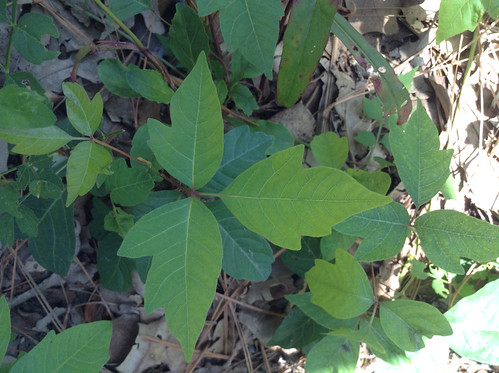
If you are a forager one of the first plants you need to be able to recognize is Poison Ivy...in all it's disguises. This is the true bane of those who wander the wild (and not so wild!) places. If you are allergic to the urushiol oil it produces this plant can cause havoc with you any time of the year. Time and again people suffer reactions internally from breathing the smoke from burning logs with a Poison Ivy vine attached. Due to the hard-to-remove properties of urushiol, clothes or pets that brushed against this terrible vine can cause a rash long after initial contact had occurred. Luckily, Poison Ivy has several distinctive features that make it easy to train your eye to spot it regardless of its attempts to hide!
Let's start with something almost everyone has heard "Leaves of three, let it be!" Okay, sounds good but what does this actually mean? Well, every variation of Toxicodendron radicans will have compound leaves consisting of three leaflets. While there are non-dangerous plants with compound leaves having three leaflets it is good to be wary when first encountering such a plant until further observations can be made.
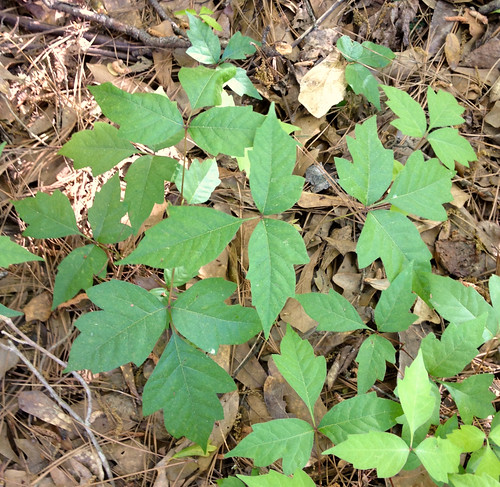
Looking at the pictures here notice that the center leaf is mostly (but not always perfectly) symmetrical, having very similar shape and area on either side of its center vein. However, the two side leaflets are asymmetrical with the side nearer the center leaflet being significantly thinner in area than the sides away from the center leaflet. The "away" sides will be much thicker and will usually have one or more lobes. Think of these side leaflets as being mitten-shaped with their thumbs pointing away form the center leaf.
These three leaflets can vary in "pointy-ness" ranging from almost like spearheads down to rounded ovals. In each case though the symmetrical/asymmetrical areas of the center/sides leaves will remain.
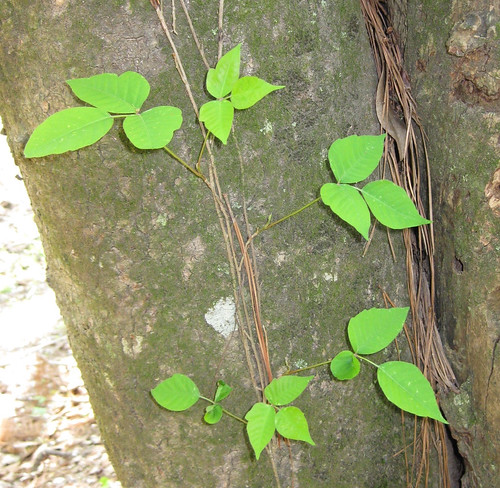
Another annoying thing that interferes with identification of poison ivy is that its leaves can vary in size from barely an inch across up to the size of dinner plates. If you are used to one size leaflet you may not spot a much bigger/smaller version until it's too late.
Now lets look at the plant in its entirety. It is a vine which can creep along the ground but prefers to climb up trees, fences, walls, or any other vertical surface it can grab. How does it grab the surface? Not using a few long tendrils like Grapes or Passionvine but rather with thousands of short hairs which hold the vines tightly against the tree/wall/old tractor/etc. In Texas (and other states of lesser importance) its always smart to avoid touching hairy vines tight against a surface. Many of these, even though not Poison Ivy, produce sap which can still cause irritation and rashes on bare skin.
Hairy vines = bad vines!
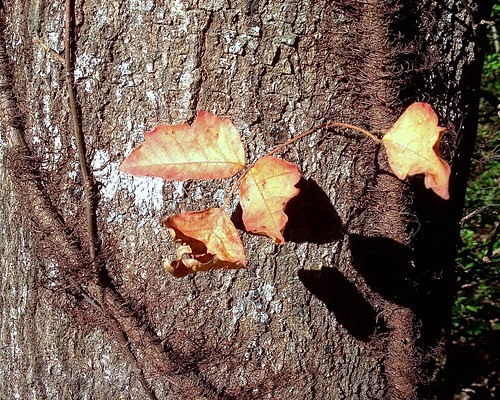
Poison Ivy creeping along the ground.
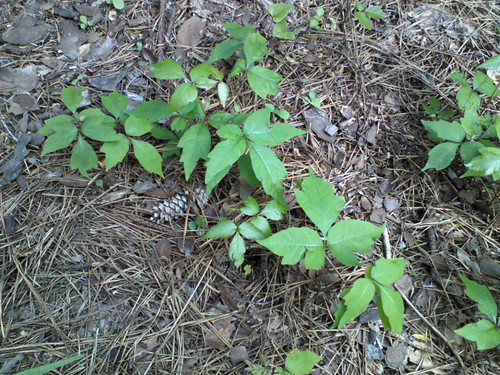
Since Poison Ivy is so good at protecting itself, it won't have any thorns. If you find a vine with thorns it won't extrude urushiol...but still pay close attention! Poison Ivy looks to climb the same trees as thorny vines such as Greenbriar, often even wrapping itself around the greenbriar vine itself. That sucks because greenbriar is delicious.
Poison Ivy flowers are green-yellow and appear in clusters. Soon they are replaced by small, green berries which turn white upon reaching maturity. The berries will have a small dot opposite their stem, making them look a bit like eyes. White berries are somewhat rare in the wild and so make a good warning that you've entered an area with Poison Ivy! Birds are unaffected by urushiol and love to feast on these plentiful fruit...thereby spreading Poison Ivy wherever they fly to.
Young, green berries before they turn white.
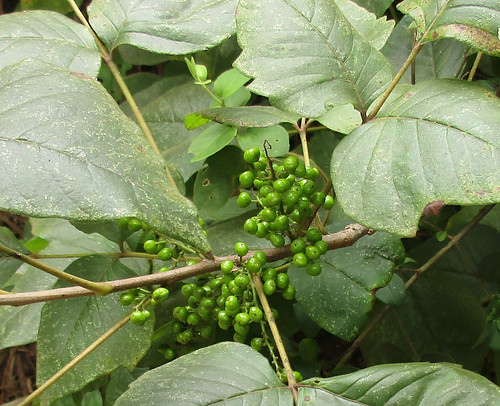
In the fall Poison Ivy leaves turn a beautiful red or yellow color, then brown before dropping from the vine. Once the leaves have dropped the hairy vines are easily seen clinging to tree trunks. Young vines will barely be thicker than a pencil lead whereas many-year old vines can be two inches thick or more.
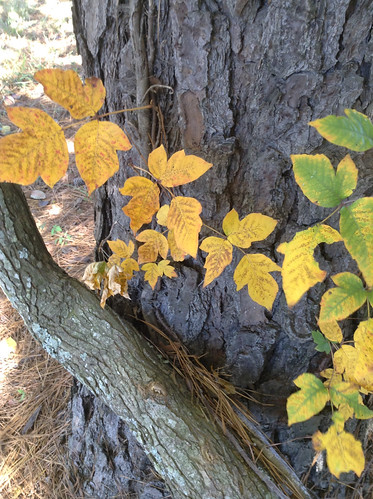
Many people claim to be resistant to Poison Ivy's urushiol and that is quite likely. The rash is actually an allergic reaction rather than a specific chemical attack. However, like all allergies one can suddenly (and usually permanently!) develop an allergic response to Poison Ivy even after years of no effect. Doesn't that just suck?
Sometimes you'll hear of someone reversing their allergy to Poison Ivy by eating one of its leaves every day when they first appear in the spring. I have not tried this as it just sounds like a bad idea to me!
If you know you're going into an area heavy with Poison Ivy I strongly recommend coating your skin with Workman's Friend Skin Barrier Cream as prevention against the urushiol from coming in contact with your skin. Please note that this barrier cream only offers protection for about four hours and it doesn't protect your clothing from absorbing this nasty plant oil. Also in light of full disclosure, I currently work for the company that produces Workman's Friend Skin Barrier Cream
If you do accidentally touch Poison Ivy the best treatment I've found is the Tecnu product line, which whom I have no financial interest. Within the first eight hours of contact use Tecnu Original Poison Oak & Ivy Outdoor Skin Cleanser, ideally before any rash appears. If your skin is already blistering carefully use Tecnu Extreme Medicated Poison Ivy Scrub to remove any residual urushiol and help heal the rash.
If you didn't buy Tecnu in advance and no blisters have yet appeared you can try scrubbing very thoroughly with some sort of mechanics soap that's specifically designed to remove engine oil and grease. Supposedly this can be somewhat effective.
Buy my book! Outdoor Adventure Guides Foraging covers 70 of North America's tastiest and easy to find wild edibles shown with the same big pictures as here on the Foraging Texas website.

